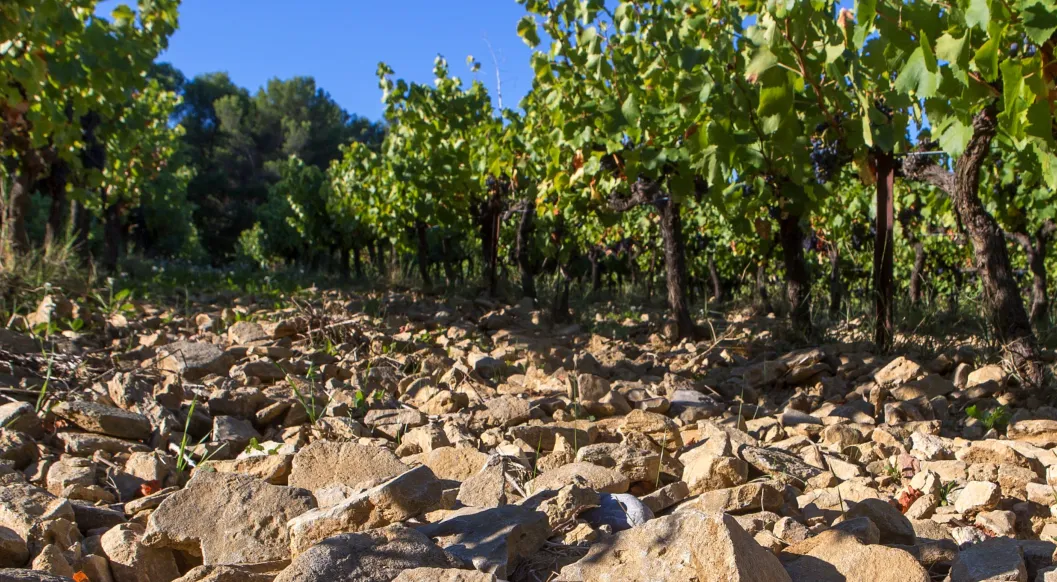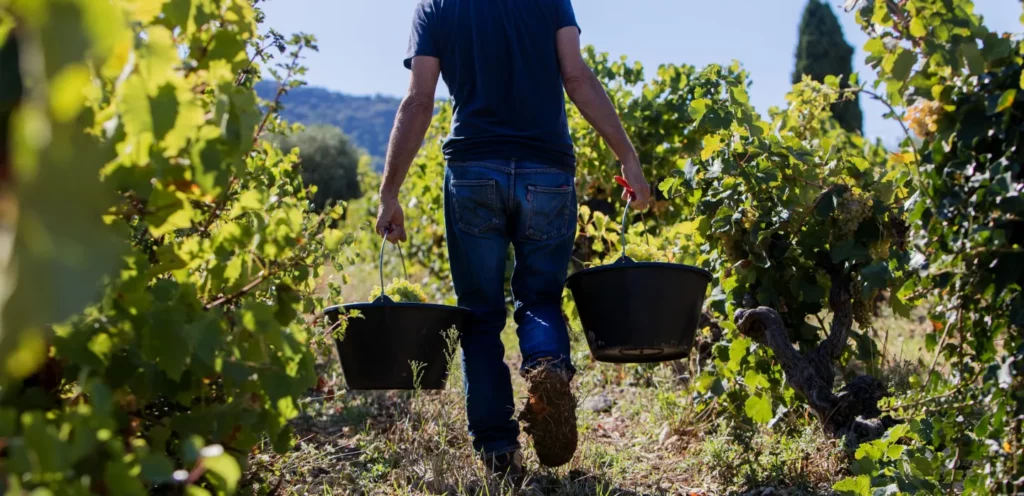When you swirl a glass of wine, your mind probably goes straight into analyzing the grape variety, the region, or the winemaker’s skill. But there is another component that can make or break a great bottle of wine: the soil the grapes are grown on. Indeed, the ground beneath the vines doesn’t just feed them. It affects the vintage itself : its structure, freshness, and even aromas.
So how is it that the same grape can sometimes give you a light, airy red and other times a bold, terroir-driven powerhouse? The answer lies right under your feet.
The role of soil in vines and wine
In viticulture, soil is never just an afterthought. It’s what feeds the vine and gives it the water it needs to thrive. Its minerals, ability to hold or drain moisture, and even its texture…all those components play a part in shaping the final taste of a bottle and the enjoyment it brings. For example, a soil with few nutrients might seem like a setback, since it would have limited yields, when in fact, it often concentrates the aromas in the few grapes that remain. On the contrary, a soil that’s too fertile means that the vine will spend most of its energy growing leaves and wood instead of concentrating it into its fruit. It’s all about balance!
This is why the soil has such a direct impact on the style of a wine. It guides its ripeness, balances out its sugar and acidity levels, defines its tannins, and even builds its aromatic profile. That is the essence of the word terroir : a subtle interplay of soil, climate, exposure, and human talent and creativity.
The main types of soil and how they influence wine
In France, we’re lucky to have an incredible patchwork of terroirs and soil. At Xavier Vignon, we tend to each of them like we would a garden, coaxing each vine into giving the very best of its potential. Here’s a quick look at the major types of soils and the role they each play in the glass.
Limestone soils
Formed from calcium carbonate-rich rocks, often of marine origin, limestone soils bring wines a trademark freshness and a lot of minerality. They drain water efficiently while holding onto moisture, which protects the wine from extreme weather conditions. Here in the Rhône Valley, this type of soil can be found at the foot of the famous Dentelles de Montmirail, where it gives Grenache its signature tension and minerality. This is the case, for example, with our Gigondas cuvée, sourced from the finest natural sites of the massif.
Clay soils
Clay is heavy, dense, and cool and holds onto water like a sponge. This results in powerful and full-bodied wines of real depth. Reds from clay soils tend to be structured, with firm tannins and plenty of aromatic richness, while white wines produced from these soils exhibit a round, almost creamy texture. Take Gigondas, for example. Its famous stony red clays are a hallmark of the region. It’s on these soils that Xavier crafts part of his Grenache and Syrah wines.
Sandy soils
It’s the perfect yin to clay soil’s yang. Sandy soils are light and free-draining, which encourages the vine to send its roots deep down in search of nutrients, refining its own growth along the way. Wines from sandy soils tend to be elegant, fruity, and easy to drink. Reds show polished tannins and a silky texture, while whites stand out with their crisp acidity and bright, juicy fruit aromas.
Volcanic soils
Born of lava and ash, these soils, found in regions such as Auvergne or Sicily, are rich in essential minerals. In the glass, this mix of iron, magnesium, and potassium is truly magical, translating into wines of dazzling intensity, acidity, and a distinct, almost saline minerality. They often have recognisable aromatic profiles, such as smoky notes, flint, or even cold ash notes. The result is wines of real character that win people over with their complexity and depth.
Schist soils
Schist is a layered rock that soaks up heat during the day and releases it at night. It also drains fairly well, forcing the vine’s roots to dig deep to search for nutrients. You won’t find much of this type of soil in the Rhône Valley, but it shows up in places like the Roussillon or the Loire Valley. On these terroirs, schist produces wines of good intensity, such as concentrated reds and whites marked by floral aromas and a strong mineral streak.
Granite soils
Made up of quartz, feldspar, and mica, granite soils (which can be found in the northern Rhône Valley) are poor, acidic, and highly draining. While this might not sound very appealing, it actually creates wines brimming with energy and nerve. For instance, reds from granite terroirs can be delicate yet vibrant, with lively acidity and plenty of flavor. White wines are often fruity, with a lot of mineral tension. These are precise, streamlined wines, almost airy in their style.
Galets roulés soils (rolled pebbles)
The large, round pebbles are a hallmark of Châteauneuf-du-Pape. They heat up in the sun during the day and release that warmth at night, helping grapes ripen to perfection. The resulting wines are sunny, round, and generous, with unapologetic power. Discover our Châteauneuf-du-Pape Blanc 2023, a beautiful expression of this terroir.
The emblematic terroir of Beaumes-de-Venise
At Xavier Vignon, it’s impossible to elaborate on soils without mentioning our iconic terroir of Beaumes-de-Venise. Nestled at the foot of the Dentelles de Montmirail and nicknamed the “appellation with two faces,” Beaumes-de-Venise boasts an exceptional diversity of soils: white Cretaceous earth, grey Jurassic soils, and Triassic marl. This geological richness, combined with a thriving biodiversity (think forests, fruit trees, and olive groves), gives birth to wines that are fresh, distinctive, and full of personality.
Discover ourBeaumes-de-Venise🍷
Why does the same grape taste different depending on the soil?
That’s the whole point of terroir and of the winemaker’s talent! A Sauvignon Blanc grown in France will never taste the same as a wine from the same grape grown in New Zealand. The same goes for a Pinot Noir from Burgundy compared to one from Oregon, or even a Cabernet Franc grown on gravel versus limestone soils.The soil acts like a conductor. It doesn’t alter the grape’s DNA, but it does shape how the grape expresses itself, influencing its intensity and aromas. That’s why two neighboring parcels, just a few meters apart, can produce wines that taste worlds apart.
How do winemakers reveal the expression of a terroir?
The role of a good winemaker is to work with this diversity of soils to produce the best possible wine as an outcome. This process begins with selecting the right grape variety for each parcel, followed by coaxing the best from these vines through proper care. This includes covering crops to protect the soil, rotating plants at the base of the vines to provide essential nutrients, ploughing to aerate the soil, and treating the vines with care to maintain a healthy ecosystem.
This work then continues in the cellar, where the winemaker’s decisions will make or break a wine. The goal here isn’t to hide the nuances of terroir behind a heavy hand but to highlight them. It’s a constant dialogue between human talent and nature. The soil provides the raw material, but it’s the winemaker who shapes it into revealing its true personality.
So, ready to taste a terroir?
Next time you’re enjoying a glass of wine, take a moment to think about what could have lain beneath the vine. Is it pale, chalky limestone soil? Or a dark, mineral-rich volcanic earth?
At Xavier Vignon, we like to remind you that every sip is a meeting with a terroir. Behind the aroma of red fruit, the freshness of a finish, or the finesse of a tannin, there’s always a soil expressing itself. So when you raise your glass, remember: you’re tasting more than a grape or a vintage. You’re tasting a soil, a story, an identity.
Cheers!


